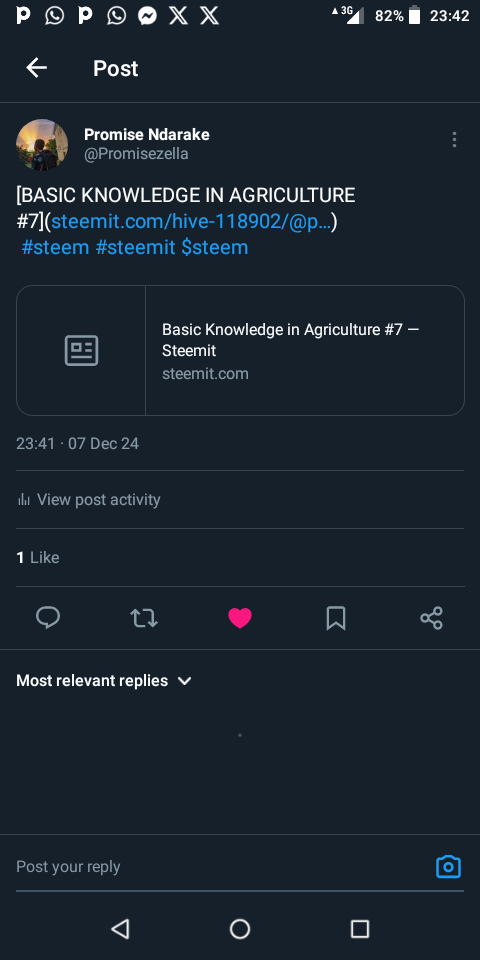Greetings fellow Steemians, let's learn a bit about agriculture.
WHAT ARE THE DIFFERENT TYPES OF CASSAVA VARIETIES, DIFFERENTIATE THEM IN TERMS OF YIELD, DISEASE RESISTANCE, ETC. |
|---|
When it comes to different types of cassava varieties, there are many of them, but I will be emphasizing just a few of them.
| CASSAVA VARIETIES |
|---|
Cassava varieties include:
- TMS 95/0505 is a type with high yield and resistance to Cassava Mosaic Disease (CMD).
- TMS 91/02324 possesses high yield and resistance to Cassava Mosaic Disease (CMD) and Cassava Brown Streak Disease (CBSD).
- NASE 13 and NASE 14 are varieties known for their high resistance to Cassava Brown Streak Disease (CBSD).
There are more varieties of cassava, but the few I just mentioned are best known for their high yield and disease resistance.
LIST COMMON PESTS & DISEASES THAT AFFECT CASSAVA AND HOW THEY CAN BE CONTROLLED |
|---|
| COMMON PESTS OF CASSAVA |
|---|
There are varieties of pests that mostly attack cassava. Let's get to know a few of them:
Cassava whitefly: This pest is very common in cassava farms; they transmit diseases like Cassava Mosaic Disease. Control methods used for this pest include insecticidal soap or the use of yellow sticky traps.
Termites: They cause damage to the stems and roots of cassava plants. Control methods include applying termiticides, removing infected plants, and using other termite-resistant varieties.
Cassava Hornworm: This pest in particular reduces the yield of cassava plants. The primary control method is hand-picking and destroying them.
| COMMON DISEASES OF CASSAVA |
|---|
There are also several varieties of diseases. I will just list a few of them:
Root rot: This disease causes the rotting of the roots of cassava plants, which may lead to the death of the plant. Control methods include applying fungicides, improving soil drainage, and avoiding waterlogging.
Cassava Bacterial Blight: This disease causes rotting of the stems and leaf blight. Control methods include applying copper-based bactericides and removing infected plants.
WHAT ARE SOME POST-HARVEST HANDLING AND PROCESSING TECHNIQUES FOR CASSAVA TUBERS? |
|---|
| POST-HARVEST HANDLING |
|---|
When it comes to processing cassava, the process is usually step by step, which I will list below based on my own experience:
| HARVESTING |
|---|
Harvesting of cassava must be done at the right time; this is when the cassava is fully matured, in some instances, 6 months or 10 months, depending on the cassava varieties. Harvesting is done by digging out the cassava from the ground, and this must be done carefully to avoid damaging the cassava.
| PEELING |
|---|
After harvesting, the next process is peeling, which involves getting rid of the cassava tuber's skin or covering.
| WASHING |
|---|
After peeling, it must be washed to remove the sand and other dirt; this is done to avoid impurities during processing.
After the few processing techniques mentioned above, the cassava can now be used in the production of any desired products such as cassava flour, garri, fufu, etc.
Thanks for reading, friends. I would love to invite
@imohmitch
@us-andrew
@sampson09
Cc,
@hive-118902



Welcome to steem-agro!
MODs Comment/Recommendation:
Thank you so much for posting in our community.Also try to engage with other participants by doing meaningful comments which will increase your chances of winning.I am wishing you all the best in the contest.
Remember to always share your post on Twitter using these 3 main tags #steem #steemit $steem

Downvoting a post can decrease pending rewards and make it less visible. Common reasons:
Submit
Thanks for approving
I will do my possible best for the community
Downvoting a post can decrease pending rewards and make it less visible. Common reasons:
Submit
https://x.com/Promisezella/status/1865527071901888821?t=VHNhqx80MOdemnX5DQ9trw&s=19

Downvoting a post can decrease pending rewards and make it less visible. Common reasons:
Submit